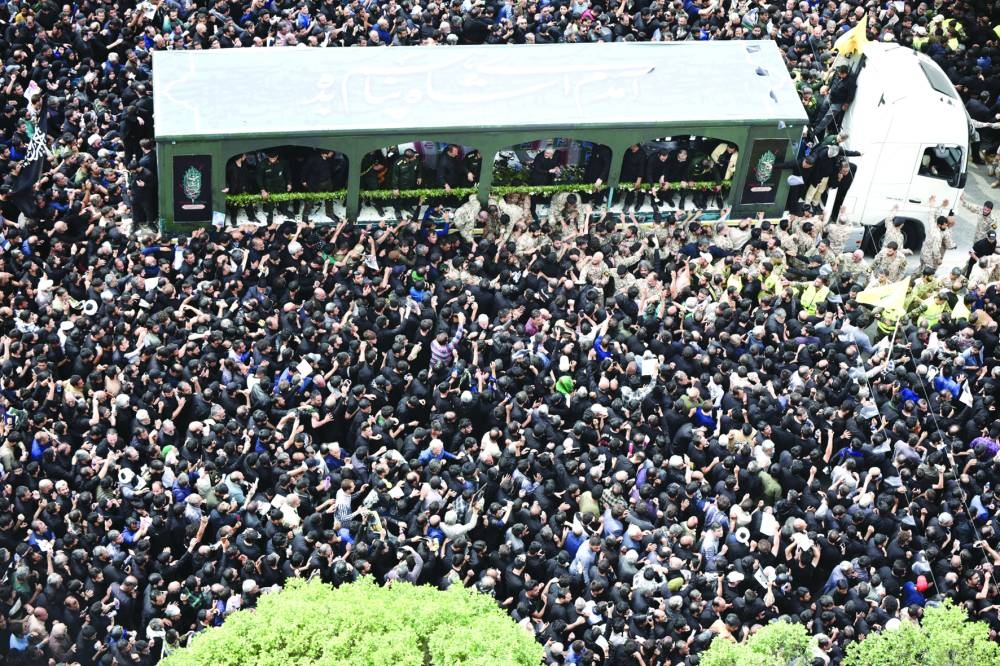President Ebrahim Raisi was buried in the Iranian city of Mashhad yesterday as many thousands of mourners packed its streets for his funeral, four days after he died in a helicopter crash, footage broadcast by Iranian media showed.
Raisi, 63, was widely seen as a candidate to succeed 85-year-old Supreme Leader Ali Khamenei, who wields ultimate power in Iran.
Mohamed Mokhber, who had been first vice-president, is serving as interim president until a June election.
The burial ceremony was attended by Iranian government and military officials, as well as religious personalities.
Flowers were thrown at his coffin as it moved slowly aboard a truck through throngs of mourners to be buried at the gold-domed Imam Reza shrine.
Raisi hailed from Mashhad, 900km (560 miles) east of Tehran.
Some mourners held aloft placards paying tribute to Raisi as the “man of the battlefield” as a large truck carrying his body drove through the sea of mourners.
Posters of Raisi, black flags and Shia symbols were erected along the streets of Mashhad, particularly around Raisi’s final resting place – the Imam Reza shrine, a key mausoleum visited by millions of pilgrims every year.
Earlier thousands of people holding images of Raisi and waving flags lined the streets of Birjand, capital of the eastern province of South Khorasan, for the procession of Raisi’s coffin.
Raisi was South Khorasan’s representative in the Assembly of Experts, a clerical body in charge of selecting or dismissing Iran’s supreme leader.
The 63-year-old died on Sunday alongside Foreign Minister Hossein Amirabdollahian and six others after their helicopter went down in the country’s mountainous northwest while returning from a dam inauguration on the border with Azerbaijan.
Iran proclaimed five days of mourning for Raisi.
A ceremony was held to commemorate Amirabdollahian at the foreign ministry in Tehran, where acting Foreign Minister Ali Bagheri Kani described him as a martyr who had “guaranteed the revolutionary nature of the foreign ministry”.
Amirabdollahian was buried south of Tehran in the city of Rey’s Shah Abdolazim shrine, a mausoleum where notable Iranian politicians and artists are interred.
The presidential election has been scheduled for June 28.
A presidential election in Iran had not been expected until next year, and the crash has caused some uncertainty as to who will succeed Raisi, with some expressing concern about the upcoming president.
“How do I find someone like him? I’m really worried about that,” said 31-year-old cleric Mohsen at a gathering in Tehran. “As far as I know, we don’t have anyone of his stature.”
Raisi was elected president in 2021, succeeding the moderate Hassan Rouhani at a time when the economy was battered by US sanctions imposed over Iran’s nuclear activities.
Raisi’s time in office witnessed mass protests, a deepening economic crisis and unprecedented armed exchanges with arch-enemy Israel.
After his death, Russia and China sent their condolences, as did the North Atlantic Treaty Organisation (Nato), while the UN Security Council observed a minute’s silence.
Messages of condolence also flooded in from Iran’s allies around the region, including the Syrian government as well as Hamas and Hezbollah.

Mourners attend the funeral of late president Ebrahim Raisi in the city of Mashhad.
